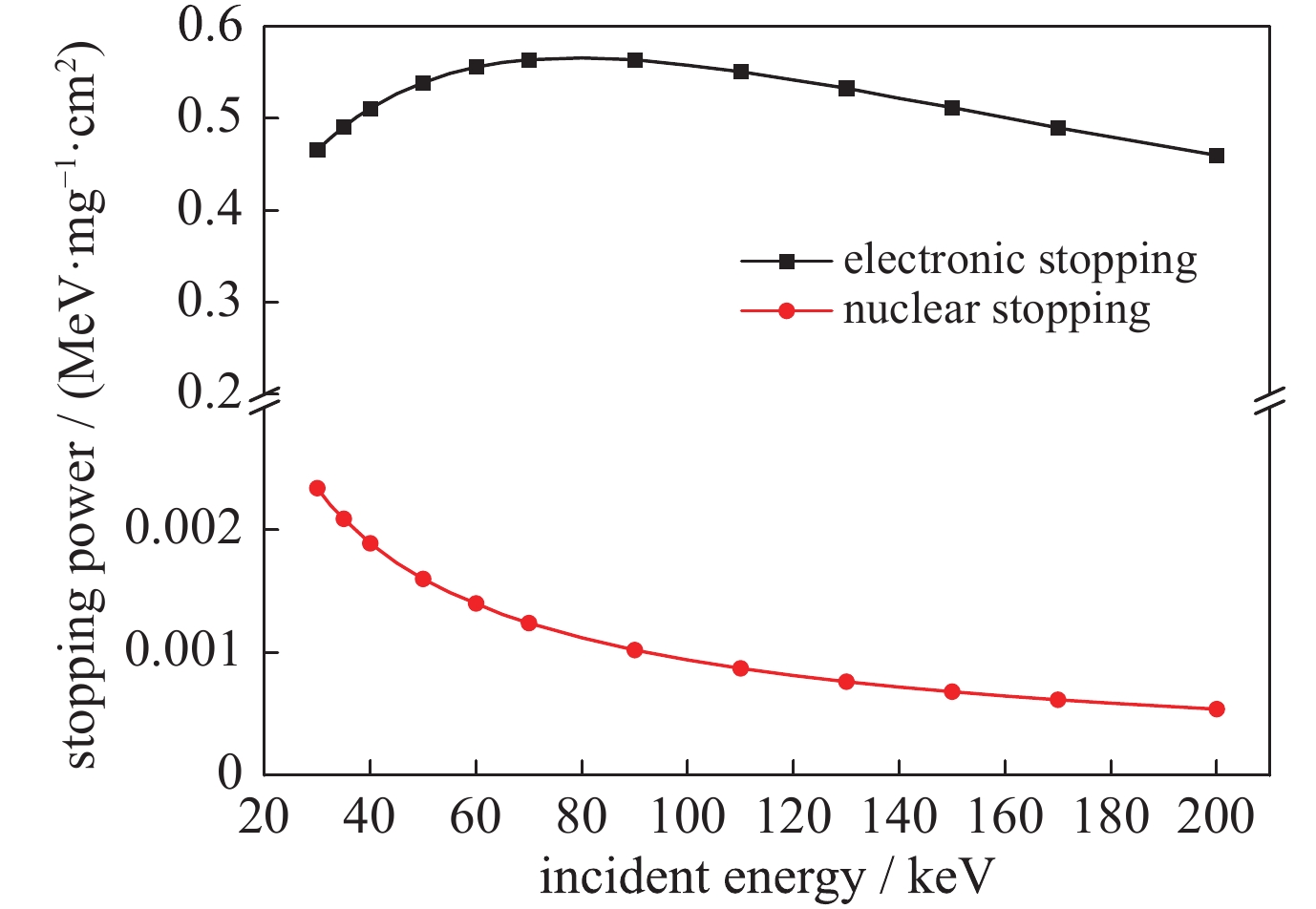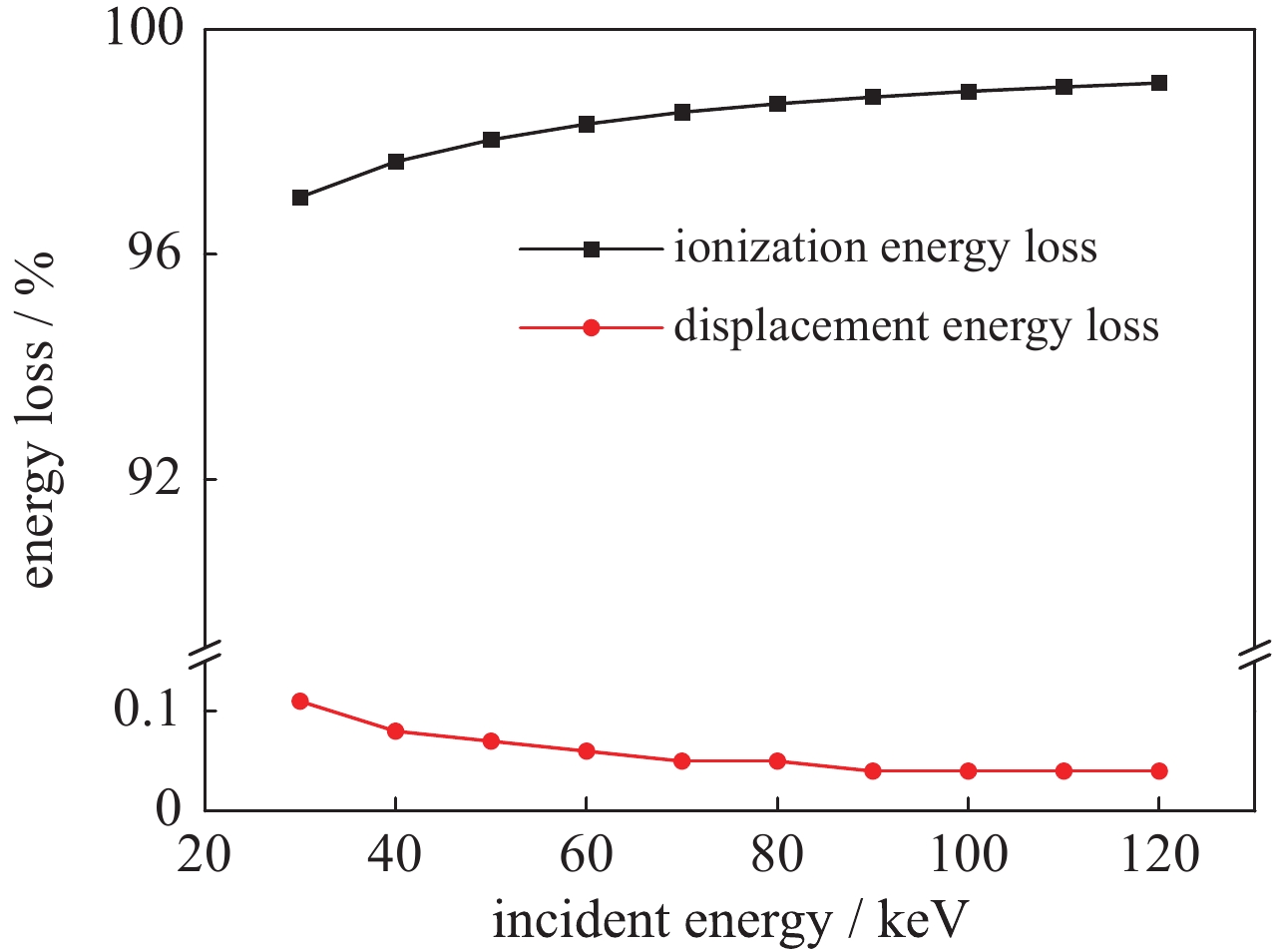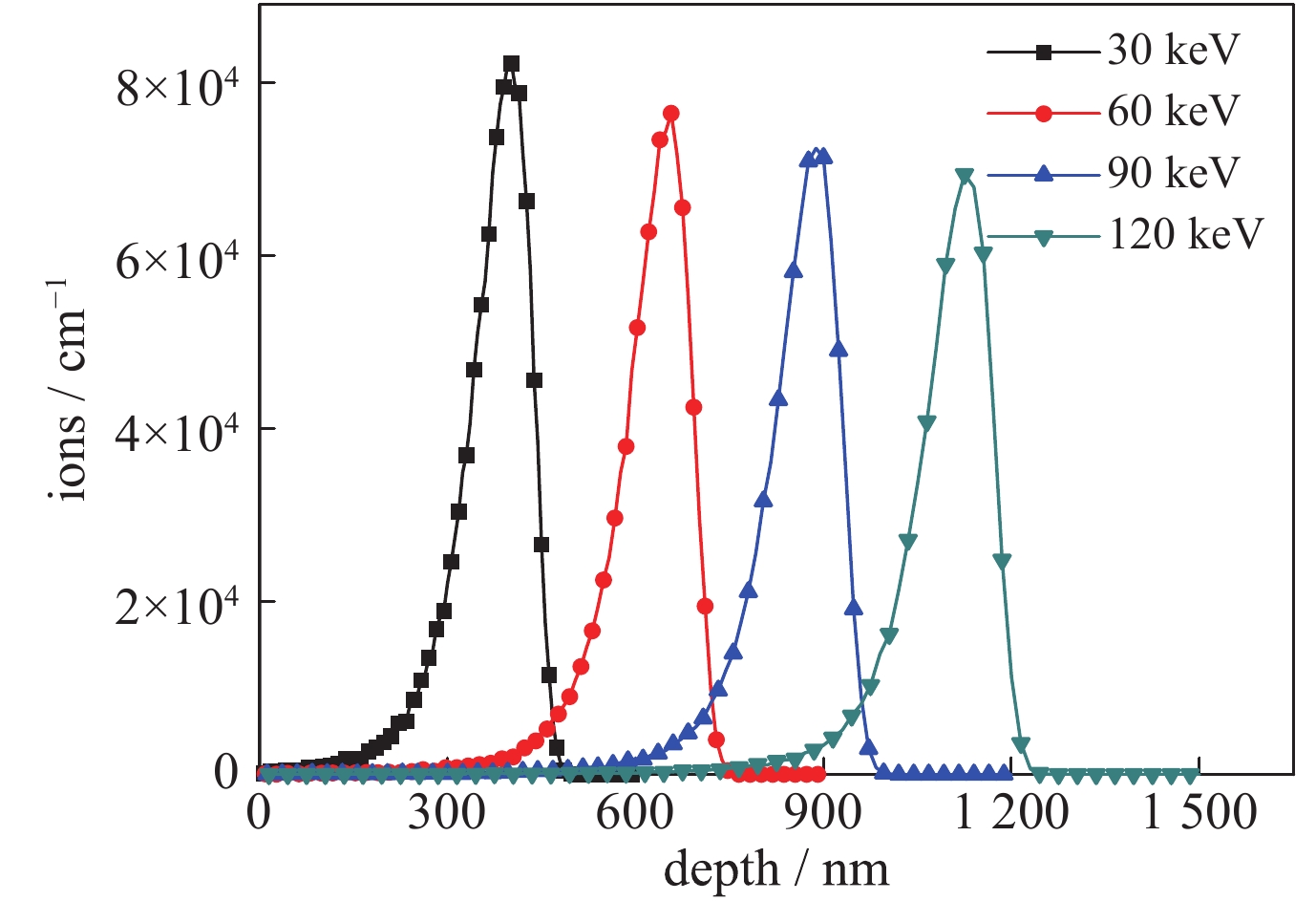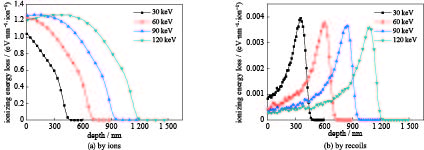Analysis of physical effects of borosilicate glass coverslips irradiated by protons
-
摘要: 作为航天器电源系统的重要组成部分,太阳电池需要更高的转换效率和可靠性以及更长的使用寿命。通过在太阳电池表面覆盖抗辐照玻璃盖片,可以增强太阳电池对粒子辐射的防护,延长太阳电池的服役寿命,使航天器获得可靠的能源供应。硼硅酸盐玻璃就是一种理想的太阳电池玻璃盖片材料。采用蒙特卡罗方法,结合SRIM软件模拟研究质子辐照硼硅酸盐玻璃的损伤物理机理。基于粒子与物质相互作用的理论以及基本公式,通过分析不同入射能量的质子在硼硅酸盐玻璃中的阻止本领、电离能损、位移能损、空位的产生情况,对辐照损伤的物理机制进行研究。结果表明:能量为30~120 keV的质子辐照损伤主要发生在硼硅酸盐玻璃表面;质子沉积、空位分布等均为Bragg峰型分布;电离能损是能量损失的主要部分,随入射能量的增加而增大,导致电子的电离和激发;位移能损在玻璃内部随能量降低而增大,导致硼、氧和硅等空位缺陷的产生;电离效应和缺陷的产生是硼硅酸盐玻璃色心形成的重要原因。Abstract: As an important part of the spacecraft power system, solar cells require high conversion efficiency and reliability and a longer service life. By using an anti-irradiation glass coverslip, the protection of the solar cell against particle radiation can be enhanced, the service life of the solar cell can be prolonged, and the spacecraft can obtain a reliable energy supply. Borosilicate glass is an ideal glass cover material for solar cells. In this paper, Monte Carlo method is combined with SRIM software to study the physical mechanism of damage of proton irradiated borosilicate glass. Combining the theory of particles-matters interaction with the basic formula, based on analyzing the stopping power, ionization energy loss and displacement energy loss of protons in different borosilicate glass, and the generation of vacancies, the physical mechanism of the damage was analyzed. The results show that the proton irradiation damage with energy of 30−120 keV mainly occurs on the surface of borosilicate glass; proton deposition and vacancies distribution follow the Bragg curve; ionization energy loss is the main part of energy loss, which increases with the increase of incident energy, leading to ionization and excitation of electrons; displacement energy loss increases with the decrease of energy in the glass, which leads to the vacancy defects of boron, oxygen and silicon. Ionization effect and defects are important reasons for the formation of color center in borosilicate glass.
-
Key words:
- radiation effects /
- proton beam /
- solar cell coverslip /
- borosilicate glass /
- Monte Carlo method
-
表 1 硼硅酸盐玻璃组成元素及参数
Table 1. Borosilicate glass composition elements and parameters
element atom stoich/% displacement energy/eV binding energy/eV surface energy/eV B 7.04 25 3 5.73 O 64.10 28 3 2.00 Na 2.33 25 3 1.12 Al 0.82 25 3 3.36 Si 25.50 15 2 4.70 K 0.16 25 3 0.93 表 2 不同能量质子在硼硅酸盐玻璃中的射程及射程分散
Table 2. Range and straggling of protons in borosilicate glass at different energy
energy of protons/keV range/μm longitudinal straggling/nm 30 0.366 77.9 40 0.452 82.9 50 0.533 87.0 60 0.613 90.3 70 0.690 93.2 80 0.767 96.1 90 0.845 98.8 100 0.923 101.4 110 1.000 103.9 120 1.080 106.3 -
[1] 孙承月. 太阳能电池板玻璃盖片的空间带电粒子环境损伤效应研究[D]. 哈尔滨: 哈尔滨工业大学, 2007.Sun Chengyue. An investigation on the space charged particale environmental effects of the cover-glass for solar cell[D]. Harbin: Harbin Institute of Technology, 2007) [2] 高剑锋, 张恒. 空间太阳电池抗辐照研究[J]. 电源技术, 2017, 41(7):1100-1103. (Gao Jianfeng, Zhang Heng. Anti-irradiation research of space solar cells[J]. Chinese Journal of Power Sources, 2017, 41(7): 1100-1103 doi: 10.3969/j.issn.1002-087X.2017.07.046 [3] 邓力. 国内外特种玻璃研发与应用新动态[J]. 玻璃与搪瓷, 2018, 46(1):38-48. (Dengli. The recent tendency of development and application of special glasses at home and abroad[J]. Glass & Ename, 2018, 46(1): 38-48 [4] 万军鹏, 程金树, 汤李缨, 等. 浅谈硼硅酸盐玻璃的应用现状和发展趋势[J]. 玻璃, 2004, 31(5):21-25. (Wan Junpeng, Cheng Jinshu, Tang Liying, et al. The application state and development trend of borosilicate glass[J]. Glass, 2004, 31(5): 21-25 doi: 10.3969/j.issn.1003-1987.2004.05.004 [5] 彭海波, 刘枫飞, 张冰焘, 等. Xe离子束辐照硼硅酸盐玻璃和石英玻璃效应对比研究[J]. 物理学报, 2018, 67(3):252-260. (Peng Haibo, Liu Fengfei, Zhang Bingtao, et al. Comparative studies of irradiation effects in borosilicate glass and fused silica irradiated by energetic Xe ions[J]. Acta Physica Sinica, 2018, 67(3): 252-260 [6] 王铁山, 张多飞, 陈亮, 等. 辐照导致硼硅酸盐玻璃机械性能变化[J]. 物理学报, 2017, 66(2):269-276. (Wang Tieshan, Zhang Duofei, Chen Liang, et al. Irradiation-induced modifications in the mechanical properties of borosilicate glass[J]. Acta Physica Sinica, 2017, 66(2): 269-276 [7] 王庆艳, 耿洪滨, 李兴冀, 等. 低能质子辐射硬质硼硅玻璃的模拟计算[J]. 哈尔滨工业大学学报, 2011, 43(1):7-11. (Wang Qingyan, Geng Hongbin, Li Xingji, et al. Simulation of radiation effects on hard borosilicate glass by low-energy protons[J]. Journal of Harbin Institute of Technology, 2011, 43(1): 7-11 doi: 10.11918/j.issn.0367-6234.2011.01.002 [8] Ziegler J F, Biersack J P, Ziegler M D. SRIM–The stopping and range of ions in matter[M]. North Carolina: Lulu Press Co, 2008. [9] 汤家镛, 张祖华. 离子在固体中的阻止本领、射程和沟道效应[M]. 北京: 原子能出版社, 1988.Tang Jiayong, Zhang Zuhua. The stopping power, range and channel effect of ions in solids[M]. Beijing: Atomic Energy Press, 1988 [10] 王同权. 高能质子辐射效应研究[D]. 长沙: 国防科学技术大学, 2003.Wang Tongquan. The research on the radiation effects induced by high-energy proton[D]. Changsha: National University of Defense Technology, 2007 [11] 乔松林. α粒子输运的数值模拟[D]. 绵阳: 中国工程物理研究院, 2005.Qiao Songlin. Numerical simulation of α particle transport[D]. Mianyang: China Academy of Engineering Physics, 2005 期刊类型引用(1)
1. 付祯玮,张超霞,王宇,郝景晨,杨荣国. 单周期结构极化晶体同时产生二倍频和三倍频光场研究. 量子光学学报. 2023(03): 45-51 .  百度学术
百度学术其他类型引用(2)
-






 下载:
下载:






